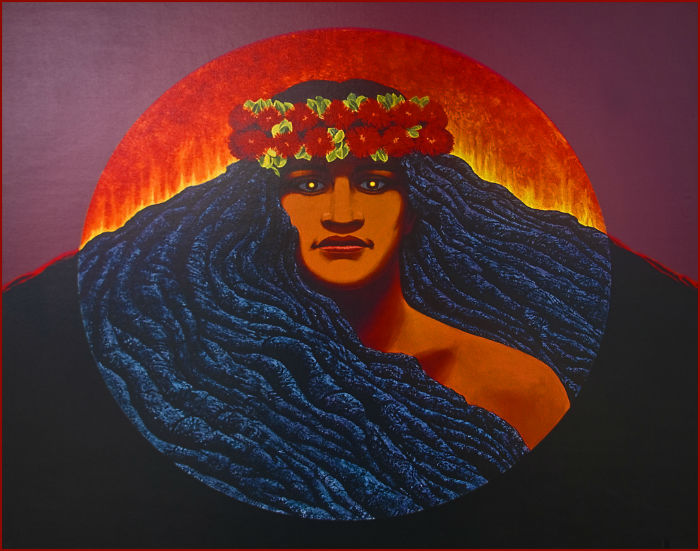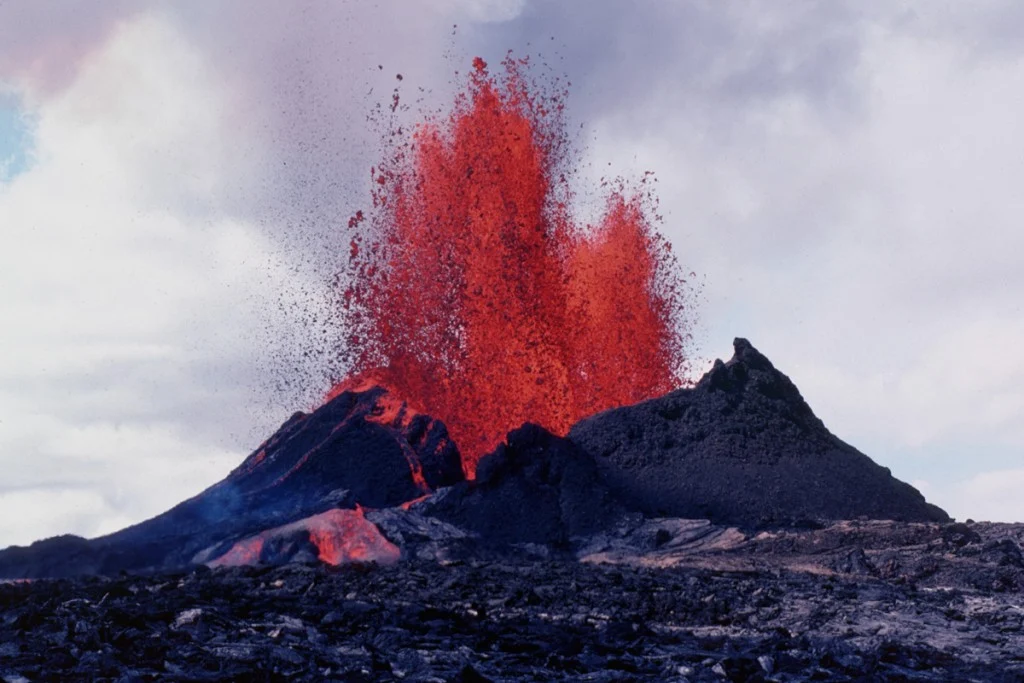Table of Contents
Kīlauea, one of the most active volcanoes on Earth, is a central geological and cultural landmark on Hawaiʻi Island, also known as the Big Island. Its frequent eruptions and dynamic landscape have not only sculpted the island's physical terrain but also shaped the spiritual and cultural identity of Hawaiʻi’s people. Revered in Hawaiian mythology as the home of Pele, the goddess of volcanoes and fire, Kīlauea embodies both creation and destruction. This remarkable volcano is more than just a natural wonder—it is a living, breathing force that continues to evolve.
Geology and Formation
Kīlauea is a shield volcano, meaning it has broad, gentle slopes built up by the flow of low-viscosity lava over time. It began forming approximately 210,000 to 280,000 years ago and emerged above sea level about 100,000 years ago. Geologists believe it is fed by the Hawaiian hotspot, a plume of superheated material rising from deep within the Earth’s mantle.
Unlike stratovolcanoes like Mount St. Helens, Kīlauea’s eruptions are typically non-explosive, allowing lava to spread gradually across vast areas. This contributes to the continuous growth of the Big Island, making it the youngest and largest of the Hawaiian Islands.
Eruption History
Kīlauea has a rich and often unpredictable eruption history. It has erupted nearly continuously from 1983 to today, largely from the Puʻu ʻŌʻō vent along its East Rift Zone. This 40-year eruption changed the island’s topography significantly, adding new landmass, destroying hundreds of homes, and creating dramatic lava flows that drew scientists and visitors from around the world.
The most significant modern eruption occurred in 2018, beginning in the lower Puna district. Massive fissures opened, emitting lava that engulfed entire neighborhoods, reshaped the coastline, and displaced over 2,000 residents. Simultaneously, the summit caldera at Halemaʻumaʻu collapsed, dropping over 1,600 feet and creating a massive crater. The eruption released substantial amounts of sulfur dioxide gas, impacting air quality and visibility across the island.
After a pause, volcanic activity resumed in December 2020, with periodic summit eruptions within Halemaʻumaʻu crater, creating a lava lake that continues to captivate scientists and tourists alike. As of 2025, Kīlauea remains under close observation by the U.S. Geological Survey’s Hawaiian Volcano Observatory (HVO), with minor seismic activity, gas emissions, and deformation suggesting magma remains close to the surface.

Cultural Significance
In Native Hawaiian culture, Kīlauea is sacred. It is believed to be the home of Pele, the fiery goddess of volcanoes. According to Hawaiian legends, Pele resides in Halemaʻumaʻu crater and is responsible for the eruptions that shape the land. Her presence is respected and revered; many locals leave offerings at the crater's edge in honor of her power.
This cultural reverence highlights a deep connection between the Hawaiian people and their environment. Rather than viewing volcanic activity as purely destructive, it is often seen as part of the natural cycle of life, death, and renewal—a force that creates as much as it consumes.

Kīlauea Today: Tourism and Safety
Today, Kīlauea is a major attraction within Hawaiʻi Volcanoes National Park, drawing over a million visitors annually. Tourists can view the active crater from safe distances, explore hiking trails, walk through lava tubes, and observe how volcanic forces continually reshape the landscape.
Some of the most popular sites include:
- Halemaʻumaʻu Crater: Often glowing at night when lava is present.
- Chain of Craters Road: A scenic drive showcasing old lava flows and collapsed craters.
- Thurston Lava Tube: A walk-through cave formed by flowing lava.
- Devastation Trail: A trail through a forest destroyed by past eruptions.
Visitors are advised to check eruption updates and park alerts before visiting, as conditions can change rapidly. The National Park Service and the USGS provide detailed, real-time information to ensure visitor safety and environmental protection.
https://www.nps.gov/havo/index.htm
Scientific Research and Monitoring
Kīlauea is one of the most studied volcanoes in the world. Scientists monitor seismic activity, ground deformation, gas emissions, and thermal imagery to forecast eruptions and ensure public safety. The Hawaiian Volcano Observatory (HVO), established in 1912, is the lead agency responsible for monitoring Kīlauea and other Hawaiian volcanoes.
Recent research efforts include using drones for high-resolution imaging, deploying sensors around the caldera, and employing artificial intelligence to detect patterns in volcanic behavior. These innovations have greatly improved eruption forecasting and hazard mitigation.

Environmental and Long-Term Impact
While Kīlauea’s eruptions can be destructive, they also play a critical ecological role. Lava creates new habitats over time, and pioneering species like ʻōhiʻa lehua trees and ferns begin to colonize the barren rock. Over decades, these new lands evolve into thriving ecosystems.
Additionally, lava flows that reach the ocean expand the coastline and create new underwater environments rich in marine life. Despite the short-term devastation, the volcano contributes to the long-term renewal and biodiversity of the island.
Kīlauea is more than just a volcano—it is a living monument to the dynamic forces that have built and continue to shape the Hawaiian Islands. Its eruptions, while sometimes destructive, also symbolize renewal, resilience, and reverence. Whether you are a geologist, traveler, or cultural enthusiast, a visit to Kīlauea offers insight into the raw power of nature and the enduring spirit of the Hawaiian people.
Helpful Links
- USGS Kīlauea Volcano Updates
- Hawaiʻi Volcanoes National Park
- Kīlauea Eruption History – USGS
- National Park Eruption Viewing Tips
- Hawaiian Volcano Observatory
- Kīlauea Cultural Significance – Bishop Museum
- Live Kīlauea Webcams
Frequently Asked Questions
1. What makes Kīlauea one of the most active volcanoes in the world?
Kīlauea is considered one of the world’s most active volcanoes because it has erupted frequently for centuries, including a nearly continuous eruption from 1983 to 2018. It sits directly over the Hawaiian hotspot, where magma rises steadily from deep beneath the Earth. As a shield volcano, its low-viscosity lava flows easily, creating ongoing volcanic activity that constantly reshapes the Big Island.
2. How old is Kīlauea, and how did it form?
Kīlauea began forming between 210,000 and 280,000 years ago, emerging above sea level roughly 100,000 years ago. It developed as the Pacific Plate moved over the Hawaiian hotspot, causing repeated lava flows that gradually built the volcano’s broad, sloping shield shape. Today, it continues to grow as new lava is added to the landscape.
3. What is significant about Kīlauea’s eruption history?
Kīlauea has had many major eruptions, but the most notable modern events include:
- 1983–2018 Puʻu ʻŌʻō Eruption: Created new land, destroyed homes, and reshaped the East Rift Zone.
- 2018 Lower Puna Eruption: Opened massive fissures, displaced thousands, and caused the dramatic collapse of Halemaʻumaʻu crater.
- 2020–2025 Summit Activity: Halemaʻumaʻu has produced periodic lava lakes, drawing worldwide attention.
Kīlauea’s eruptions are monitored closely, as they can change quickly and dramatically.
4. Why is Kīlauea culturally significant to Native Hawaiians?
In Hawaiian tradition, Kīlauea is the home of Pele, the goddess of volcanoes and fire. Pele is believed to reside in Halemaʻumaʻu crater, and her power is both respected and revered. Many Hawaiians leave offerings for her, honoring her as the creator and destroyer of land. This cultural connection reflects a deep respect for the natural cycles of creation, destruction, and renewal.
5. Is it safe to visit Kīlauea today?
Yes—Kīlauea is safe to visit when guidelines are followed. The volcano is located within Hawaiʻi Volcanoes National Park, where trails, roads, and viewing areas are designed to keep visitors at safe distances. However, conditions can change quickly. Always check National Park Service alerts, eruption updates, and air-quality reports before your visit:
https://www.nps.gov/havo/index.htm
6. What are the best places to view Kīlauea and its volcanic features?
Popular viewing and exploration sites include:
- Halemaʻumaʻu Crater (night glows when lava is present)
- Chain of Craters Road (historic lava flows and scenic overlooks)
- Thurston Lava Tube (a walk-through lava cave)
- Devastation Trail (a landscape transformed by past eruptions)
These locations highlight both the destructive and creative forces of Kīlauea.
7. What happened during the 2018 Kīlauea eruption?
In 2018, Kīlauea experienced one of its most dramatic eruptions in history. Large fissures opened in the lower Puna district, releasing massive lava flows that destroyed over 700 homes, covered roads, and formed new coastline. At the summit, the Halemaʻumaʻu crater collapsed, deepening by more than 1,600 feet. The eruption reshaped the Big Island’s geography and demonstrated the immense power of Hawaiian volcanism.
8. How do scientists monitor Kīlauea?
Kīlauea is monitored by the USGS Hawaiian Volcano Observatory (HVO), one of the most advanced volcano monitoring systems in the world. Scientists use:
- Seismic sensors
- Gas analyzers
- GPS ground-deformation tools
- Drones
- Thermal cameras
- Artificial intelligence models
These technologies help forecast eruptions, improve safety, and advance volcanic research.
9. How does volcanic activity contribute to Hawaiʻi’s ecosystem?
Although eruptions can be destructive, Kīlauea also plays a vital role in creating new environments. Fresh lava forms new land that is gradually colonized by pioneer species like ʻōhiʻa lehua and ferns. Over decades, this process leads to thriving forests and habitats. Lava entering the ocean also forms new underwater ecosystems, contributing to the island’s long-term ecological renewal.
10. What is it like to visit Hawaiʻi Volcanoes National Park?
Visitors can expect dramatic volcanic landscapes, steam vents, old lava flows, scenic drives, and world-class hiking. Popular experiences include:
- Watching Halemaʻumaʻu glow at dusk (when lava is visible)
- Exploring lava tubes
- Visiting cultural sites
- Walking across old lava fields
- Learning at the Kīlauea Visitor Center
It’s one of the most unique national parks on Earth, where geology and culture blend seamlessly.
11. Why is Kīlauea important to Hawaiʻi’s identity?
Kīlauea symbolizes creation, resilience, and cultural heritage. Its eruptions shape the land, influence Hawaiian stories, and strengthen the connection between people and place. For both residents and visitors, experiencing Kīlauea offers a deeper understanding of the power that formed the Hawaiian Islands and continues to transform them today.
If you would like to read and learn more about interesting things in Hawaii! Check out our blog page here on our website!
or
